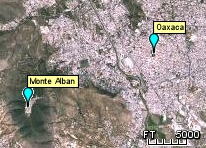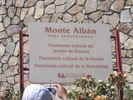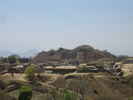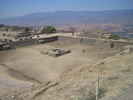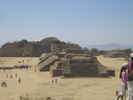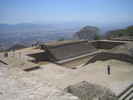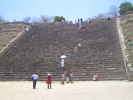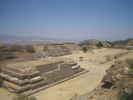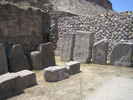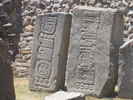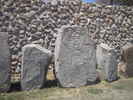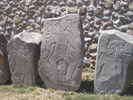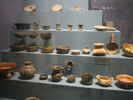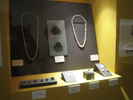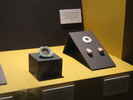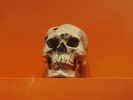The Ancient Ruins of Monte AlbanWednesday morning we got up kind of early and made our way a few blocks more north of the Zocalo, where we stumbled upon a good tour agency. We wanted to book a tour of the ancient ruins Monte Alban, which, once again, we had read about in our Moon Guidebook. When we met AZ ex-pat Ron of Chino Tours, we knew we had run into the right guy. He was full of information about places to go and things to see in Oaxaca. We were at his office at about 8:30 am, so went ahead and booked the $15/person, half-day group tour to Mt. Alban. Then we talked with him for the best part of an hour as he told fascinating stories about everything from making Mezcal (which he had learned to do, bottling his own and selling it on premises), to cooking styles, to the history & culture of the region. As our 10:00 departure time rolled around, Ron let us know that normally the $15 covered a bus ride to the ruins, but as we were the only clients that day, he was going to send us out in a private car with our own personal driver! Soon, Julio pulled up in a brand new Volkswagon "Pointer", and we were taken to ruins in nice style (and air conditioned comfort, too!). The ruins are only about 5 miles from present day Oaxaca City, and when there, one has commanding views of the three main valleys of Oaxaca in every direction. Monte Alban is thought to be one of the oldest urban complexes in Mesoamerica. It was first constructed about 500 B.C. as a ceremonial center in the ancient Olmec tradition. It was inhabited by the Zapotec Indians sometime around 350 A.D., and went thru several periods of renovation during the centuries that passed. Around 800 A.D., the decline of the Zapotecs was followed by the rise of the Mixtecs in such nearby places as Mitla and Zaachila. By 850 A.D., Monte Alban was almost deserted. It was rediscovered in the early 1800's by a Belgian traveller named Guilliame Dupaix, but it wasn't until 1931 that Mexican scientist Alfonso Caso, a statue of whom is erected on the site, first began serious archeological excavations. The site was probably a bustling city of about 40,000 people at one point, consisting of dozens of buildings on a high plateau with views for miles around in all directions. There is a ballcourt, where people played a ritual soccer-handball like game in which, it is thought, the winners or losers may have been sacrificed to the gods at the end of the game! There is at least one astronomical observatory, and a number of temples to the various gods. Also, there are a many individual residences where presumably the leaders and chosen lived. Each residence typically had a family tomb dug in the middle, where generations of ancestors, and the things they might need in the afterlife, were buried. Many, many treasures have been found in the innumerable tombs that have been excavated. These treasures include dozens of statues, masks, urns, and ceramic pieces, lots of golden sculptures and jewelry, as well as many intricate jade and turquoise pieces. It is thought that the city served as a huge marketplace for the agrarian society that existed at that time, ruling over the valleys of Oaxaca for hundreds of miles in every direction. We spent about 4 hours at Monte Alban, including about an hour in the on-site museum. It was a really special place and we truly stood in awe of everything we saw. After that, we returned with Julio to Oaxaca City, and then went to the Zocalo where we whiled away the rest of the afternoon, having some cold beers and lunch at the zocalo-side cafe Terranova, and then wandering around a bit, including taking a walk back up to the Ex-Convent and Cathedral Santa Domingo de Guzman. Later that evening while walking around the Zocalo, we ran into Ian and Ness from EILEEN NONEN and had a few drinks with them at another zocalo sidewalk cafe. |

